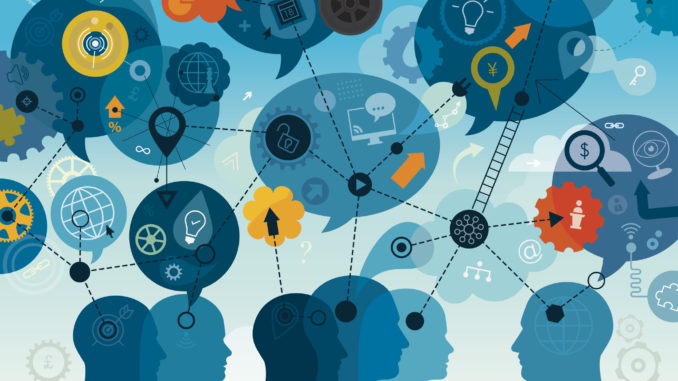
Global high-speed connectivity, smart technology infused into every business function, consumers and customers linked and empowered through social media, and Big Data generated by the Internet of Things throughout one’s ecosystem and value chain – these realities will produce high cognitive and emotional demands on humans for the highest and fastest levels of critical and innovative thinking, hyper-learning, and decision making. And since those tasks are optimized through effective teams, the highest levels of human emotional and social intelligence will be required.
That will be a challenge for many companies because of factors such as suboptimal employee engagement, internal corporate politics, or the maniacal focus on efficiency that constricts learning, innovation, creativity, and experimental risk-taking. Such environments are generally characterized by internal competition and gamesmanship, hierarchy, ego, fear, fiefdoms, and philosophies exemplified by expressions like “go along to get along,” “the boss knows best,” and “don’t challenge the status quo.”
WHAT YOU’LL NEED
What will be needed in the digital age is a work environment of psychological safety that enables an idea meritocracy evidenced by candor, challenging the status quo, data-driven decision making, permission to speak freely, rapid experimentation, hyper-learning, and allowance to make learning mistakes within financial parameters. The goal is to pursue the highest levels of human cognitive and emotional performance. That requires the right mind-sets, behaviors, and processes. How people talk to each other, how people listen, how people emotionally connect, how people manage their thinking and emotions, and how people collaborate are all examples of the granular nature of daily behavioral focus that will be required in the coming age of smart technology and the digital revolution.
HOW TO DO IT
How does one transform one’s environment to enable the highest levels of human performance? We believe the answer is to create a Hyper-Learning Community. An organization becomes a Hyper-Learning Community by going through a two-step process. First, it goes through a community-building process of group meaning-making to deconstruct and set aside individual mental models, mindsets, and current ways of working that inhibit the highest levels of cognitive and emotional engagement. And then, it works to co-create new shared values, beliefs, behaviors, and mental models through which people agree to dedicate their highest and best selves toward a common good, goal, or shared purpose.
A Hyper-Learning Community, unlike an organization, is based on the acknowledgment of human imperfection and differences, and the need for continual individual and collective learning, experimentation and development. A community is characterized by trust, candor, authenticity, transparency, compassion, and integrity. It is a psychologically safe place that enables courage – the courage to experiment, the courage to speak up, the courage to disagree with more senior people, the courage to take ownership of one’s performance, and the courage to embrace mistakes as learning opportunities.
PERFECTION AND MISTAKES
A Hyper-Learning Community acknowledges – and anticipates – that people and groups fall short of perfection. It does this by committing in advance to transparency with regard to performance strengths, weaknesses, and behavioral transgressions.
Whereas many organizations seek to punish individuals for mistakes, Hyper-Learning Communities act with a balance of compassion and discipline toward those who fall short of their commitments. These communities help us outgrow our imperfections rather than reprimand us for them. They do not seek perfection, but they do seek personal commitment to improve and an openness to learn from one’s mistakes.
Acting as an idea meritocracy, a Hyper-Learning Community seeks the practice of excellence rather than perfection from group members, regardless of rank, role, or responsibility. All members are equally responsible to each other, irrespective of rank, for their adherence to the common good, and to take responsibility for their behaviors and actions. As long as a person stays loyal to the community’s goals and values, and so long as a person stays committed to a journey of learning and self-improvement, mistakes will be looked upon as learning opportunities for all.
By acting with and through a spirit of honesty, transparency, candor, self-improvement, and compassion – the will to nurture another’s growth – a Hyper-Learning Community becomes a meritocracy, whether addressing business decisions or behavioral transgressions. In doing so, it pursues its shared intent with tolerance, acceptance, and a firm determination to perform at the highest levels humanly possible. It is a humanistic place to work. A place where, in general, one’s best-self outside of work is no different than one’s best-self at work – the only difference is the context.
CREATING A COMMUNITY
Creating a Hyper-Learning Community is hard. It takes time, patience, and the complete buy-in of senior leadership, who have to role model the desired behaviors and mindsets. It takes admitting when you don’t get it right. And sustaining a community is a daily job of every member. It is an ongoing process that requires rigor, daily practices, and holding each other accountable.
There are multiple reasons to create a Hyper-Learning Community, with the most common being: the need for implementing large strategic or operational shifts due to disruption, the need for organizational agility or large-scale innovation, the need to promote rapid workforce hyper-learning and enhanced employee engagement, and the need to accelerate and sustain organizational growth (among others). Hyper-Learning Communities are psychologically safe environments for large-scale, organization-wide disruptive change.
The biggest human obstacles to change are ego and fear. Hyper-Learning Communities are designed to mitigate ego, fear, and internal corporate gamesmanship that values fiefdoms and internal competition over community cohesiveness and collaboration. Optimizing human performance will become a key strategic differentiator over the next decades. Creating a Hyper-Learning Community is a big step in that direction.



